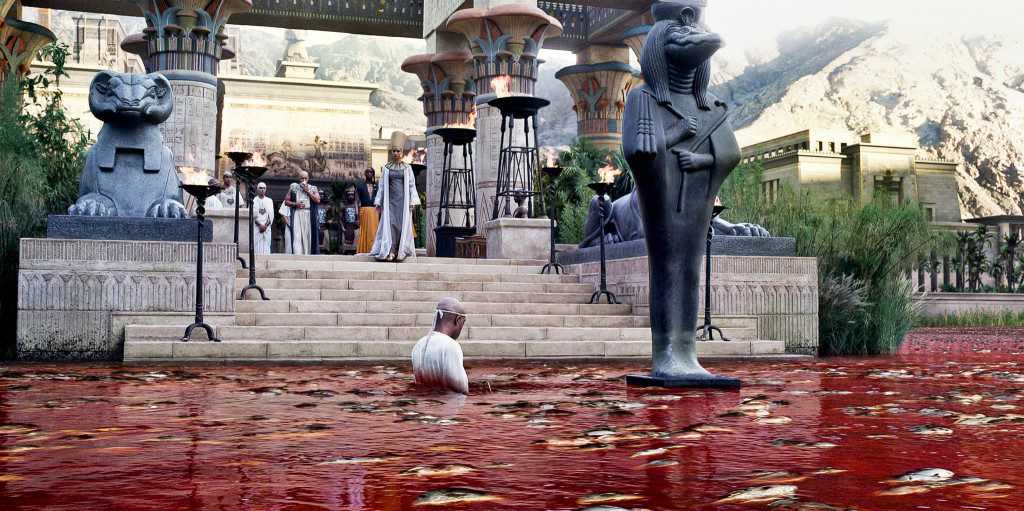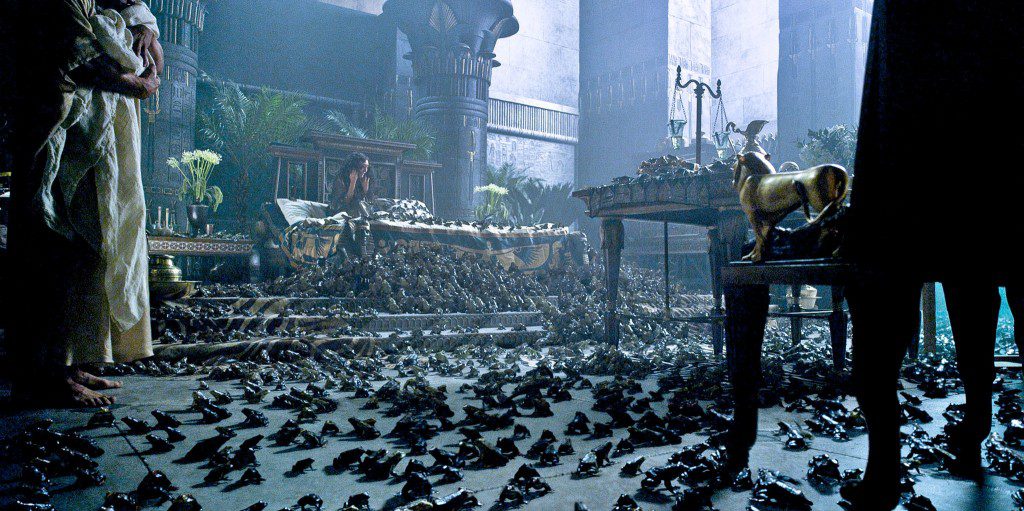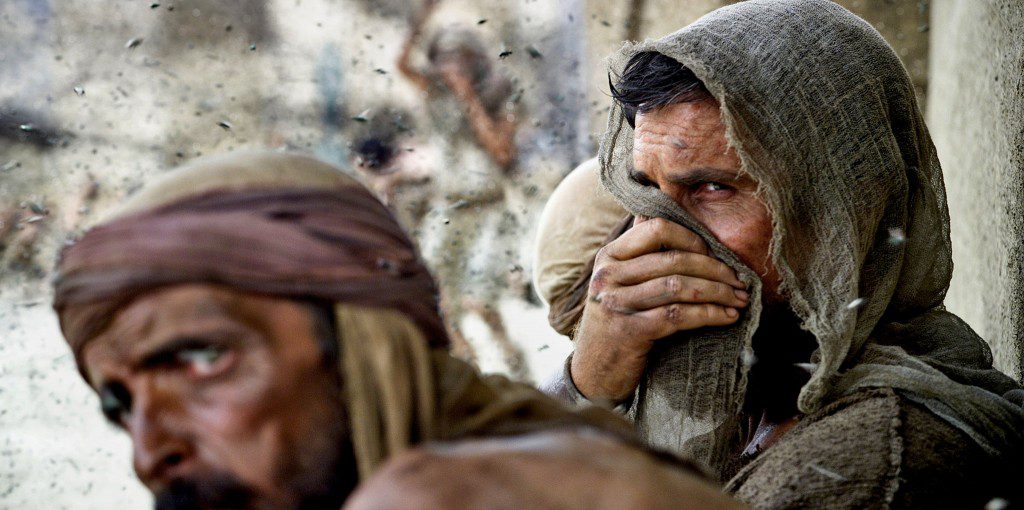The Academy has released a list of the ten films that are still in the running for the Oscar for best visual effects this year, and neither of the year’s big Bible movies made the cut.
As Jeffrey Wells puts it, the Academy favoured “nine fantasy films about exotic creatures and monsters plus one serious, intensively researched sci-fi film (i.e., Chris Nolan’s Interstellar)” rather than the “novel and in some ways genre-expanding” effects in Noah and the “impressive” effects in Exodus: Gods and Kings.
This is all the more noteworthy because the Visual Effects Society just announced last week that it would be giving Exodus director Ridley Scott a lifetime achievement award at its next awards ceremony on February 4, and two of Scott’s films — Alien and Gladiator — have actually won the Oscar for visual effects.
Oh well. This is as good a time as any, I guess, to link to the various stories on the visual effects in Exodus that have run over the past two weeks, while the people who worked on that film still thought they had a shot at a nomination.
Deadline covered both Noah and Exodus in a single article:
If Noah leans to the fantastic, Exodus tilts toward the factual. Visual effects supervisor Peter Chiang says he wanted to capture the grand scale of the adventures of Moses. But “the main thing is to be true to the historic period,” he says. “No one really knows what Egypt in 1300 B.C. looked like. So you have to imagine what existing architecture would be like, and hopefully (the film) strikes a little subconscious chord inside you, that you know this.”
Audiences will certainly know the disasters that strike Egypt in Exodus, which wonders whether the Bible’s greatest tales were borne of very real causes. Could the Red Sea have been parted by a tsunami’s receding tides? The plagues by an ecological infestation?
“Ridley wanted to convey the sense that everything could be natural phenomenon, like an eclipse or tsunami,” Chiang says. “Not just someone waving a stick at the sea.” . . .
The Wall Street Journal also spoke to Peter Chiang:
With “Exodus,” Mr. Scott returns to the swords-and-sandals pageantry he captured in “Gladiator,” another film replete with computer-generated images. Special effects have come a long way since Hollywood in the 1950s. What’s notable in “Exodus” is how computer-generated images seamlessly blend with real photography and physical effects to give the movie its epic scale. The Red Sea scene was filmed at a beach on Fuerteventura, one of the Canary Islands off the northwest coast of Africa. In close-ups of people fleeing across the sea bed, the filmmakers used the beach’s real waters.
“We rigged up a series of Jet Skis and used their propellers to drive the water against the actors,” Mr. Chiang explains. “You’ll see the foreground with Christian Bale crossing, and maybe 30 or 40 people around him, and then CG [computer-generated] water heading toward infinity, CG horses, CG Hebrews, making up the 40,000 people crossing.”
Re-creating the ten plagues visited upon the Egyptians involved a similar mix of virtual and “practical” effects. One plague was a violent hailstorm.
“Hail was interesting,” Mr. Chiang says. The special-effects team “made these pneumatic bazookas that would fire polymer balls that would bounce and shatter with the same characteristics as an ice ball.” About 30 such cannons were arranged to pepper the actors with fake hail, which splintered as it hit shields and scenery. Hail seen in the more-distant background was computer-simulated.
“The only leap of faith, really” from Mr. Scott’s plagues-as-natural-phenomena mandate, “was the death of the first born,” Mr. Chiang says. In one plague, the Nile river suddenly runs blood red. The director’s explanation, according to Mr. Chiang: “It’s a feeding frenzy of crocodiles.”
The bloody event ends up killing all the fish in the river—and kicks off an exodus of frogs from the water. The frogs, in turn, trigger a new plague by invading the Egyptians’ homes.
“Even the frogs we needed to amp up,” Mr. Chiang says. “Rather than having just a carpet of frogs, we came up with a lava flow, a [computer-generated] mudslide of frogs. They would surge and pour through doorways like a pop-concert crowd. At one time we were referring to them as the ‘World War Z’ frogs, this sort of pyramid of frogs.” . . .
And finally (for now), the New York Times looks at how four of the plagues were done:
“I tend to be someone who comes from the reality of things,” Mr. Scott said in a phone interview. “I try to reach into the information that is there and latch onto what could have been real.”
That was his thinking when it came to depicting the 10 plagues that befall the Egyptians. Though he was trying to stay true to a story about faith, Mr. Scott wanted the plagues unfold in a natural way.
Here is a closer look at four of the film’s plagues, with Mr. Scott, and the visual effects supervisor Peter Chiang, explaining what it took to bring a series of disasters to the big screen. . . .
The article has four new pictures from the film, one for each of the plagues. First, the Nile when it is filled with blood (rather than turning to blood, per se):
Then, the frogs in Ramses’ and Nefertari’s bedroom:
Then, Moses covers his mouth to protect himself from the flies:
And finally, the locusts:
For the record, two Bible films — the 1956 version of The Ten Commandments and the 1959 version of Ben-Hur — have won the visual-effects award in the past. The 1949 version of Samson and Delilah and 1965’s The Greatest Story Ever Told were also nominated but lost to Destination Moon and Thunderball, respectively.
December 7 update: Chiang also spoke to the New York Post.
Check out earlier photos and images from Exodus: Gods and Kings here:
- Unofficial photos from the set (October 22, 2013)
- The first two official photos from the film (December 30, 2013)
- Moses runs into battle (January 13, 2014)
- Sixteen photos from Entertainment Weekly, People and others (July 1, 2014)
- The first three posters (July 8, 2014)
- A sword to the throat, spears, and Moses wearing earbuds (July 17, 2014)
- Our first look at Moses’ wife (July 24, 2014)
- Four photos from Empire magazine (August 6, 2014)
- Moses’ armour and Tuya’s headgear in Entertainment Weekly (August 15, 2014)
- The “international cast” via Yahoo! Australia (August 26, 2014)
- Three more photos from Empire magazine (August 28, 2014)
- “It’s an immense production” (September 9, 2014)
- Horses, costumes, and director Ridley Scott directing (September 16, 2014)
- Kadesh-themed countdown to the trailer (September 30, 2014)
- Images from the official website, and others (October 17, 2014)
- Three more posters, plus images from Total Film magazine (October 24, 2014)
- Ten Facebook photos and video-GIFs (November 3, 2014)
- Poster, costume designs, Facebook photos and video-GIF (November 7, 2014)
- Poster, Facebook photos and video-GIF (November 11, 2014)
- Ten Facebook photos and two video-GIFs (November 18, 2014)
- Six Empire magazine photos, three Facebook photos and two video-GIFs (November 23, 2014)
- Five Facebook photos (December 1, 2014)
And check out earlier videos and my shot-by-shot trailer analyses here:
- The first trailer (July 8, 2014)
- The ‘The World’ featurette (September 3, 2014)
- The ‘Locations’ featurette (September 10, 2014)
- The ‘Costume Design’ featurette (September 17, 2014)
- The ‘Creating the Action’ featurette (September 24, 2014)
- The second trailer (October 1, 2014)
- Micro-interviews with Christian Bale and Ridley Scott (October 17, 2014)
- Interview with Christian Bale and Joel Edgerton (October 21, 2014)
- Interview with Ridley Scott (October 28, 2014)
- The ‘Something Is Coming’ and ‘Two Brothers’ TV spots (November 3, 2014)
- The 3D featurette (November 8, 2014)
- The ‘Out of My Control’, ‘Follow Me’ and ‘Remember This’ TV spots (November 10, 2014)
- The third trailer (November 10, 2014)
- The ‘Strength’ clip (November 11, 2014)
- The ‘Miriam’ clip (November 18, 2014)
- The ‘Ridley’s Epic World’ featurette (November 19, 2014)
- The ‘What Makes You Happy’ clip and the Relevant featurette (November 21, 2014)
- The Entertainment Tonight report (November 23, 2014)
- The ‘Moses’ Journey’ featurette (November 24, 2014)
- The ‘Ramses’ Journey’ featurette (November 25, 2014)
- The EPK (November 26, 2014)
- The ‘Ready Yourselves’ TV commercial (November 27, 2014)
- The ‘Plagues’ clip and the ‘Brothers vs. Brother’, ‘Gods and Kings Collide’, ‘Absolutely Epic Review’, ‘War’ and ‘Face Off’ TV spots (December 1, 2014)
- The ‘Don’t Go’ and ‘Stable’ clips (December 1, 2014)
- The ‘Egyptologists’ featurette and the Nightline report (December 2, 2014)

















